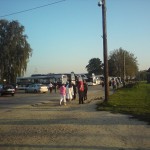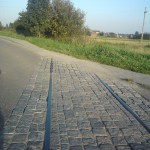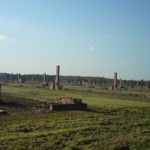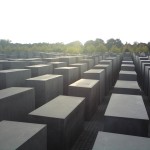Chapter 6: Auschwitz
Beyond Dreams of Aberystwyth | The Book
I have always wanted to go to Auschwitz. Strange ambition maybe. But I have always felt passionately that the Holocaust is not to be avoided – that it shows us something crucially important about ourselves if we can bear to look.
I’ve always thought one the most important things about the it was how it affected and involved everybody – victims, perpetrators and standers-by. It was designed to do that – make everybody feel complicit, even victims and survivors. Do any of us really know what you’d do if the BNP walked past your house and your family would be hurt if you didn’t wave and cheer? I’m sure I don’t. And how would that feel? Complex and contradictory feelings, and it was no different here at Auschwitz.
So here I was.
I felt – on one hand – as though time should have stopped still – that if this place is any testament to what happened here everything should have been left as it was found – the squalor, the evidence – the horror the allies must have felt when they first walked in.
Like when someone has died and you want everything to stop there and not go on.
But of course time doesn’t stop still, nor should it. Life carries on however ready for it you are. 70 years have passed, and of course things have been cleared up and things have moved on. Some sort of terms have had to be come with this: war trials, testimonies, justice, education, years of remembrance.
The local area itself has had to come to some kind of terms with its disturbing past. Oświęcim is a small Polish town, no longer living next door to the world’s most notorious death camp – but now somehow or another living next door to the remains of it. (Railway lines run all over the town; it has a ridiculously large station, built for when people were trucked in on industrial scale from all over Europe.)
Auschwitz is no longer a death camp – it is a memorial – effectively a museum. And part of the tourist trail of the region. (If you go to Krakow tourist office you will be asked if you want to visit Auschwitz amongst other the tourist sites in the area. Many are obviously deeply affected but some were clearly on an itinerary, young people joshing around.)
But of course it is appropriate that people should visit and be encouraged to come. The Polish government are very committed to preserving this site for posterity, that it remains visible and accessible and seen by the world forever. (And who am I to judge the attitudes of others approaching this place, as if my motives are any better than anyone else’s?)
So it has had to be cleared up by necessity. Barracks have been turned into exhibition rooms, neat and clean with exhibits and information boards. Floors and pathways have been concreted. There are clean toilets, a cafe, a car park for coaches – of course! – they get thousands of visitors a year.
The site itself is being maintained. Many of the barracks were hastily and shabbily made. Those that weren’t torched by the Nazis when they left should have fallen down long ago – but they are being repaired and propped up. How.. odd.. replacing the timbers, propping up the chimneys… of a concentration camp? The place occasionally smelled disconcertingly of new timber and creosote.
There is a desire for authenticity – as if timbers themselves could bear witness – as if they themselves could say something that a new piece of timber could not. At the same time, in direct contradiction, I found myself wanting the whole place to be allowed to collapse and return to the earth. Let nature do its thing. It almost it felt like it wanted to.
I walked the long perimeter around the Auschwitz-Birkenau camp – it’s massive, took ages. It smelt of new cut grass and hay that day.
When I first heard about the Holocaust I saw that image of the railway line going through the gates – here. I was shocked then that there were weeds growing through the sleepers of the track – how could plants grow again in such a place?! Wouldn’t the ground know that what had gone on and simply not be able to grow? But nature doesn’t stop. Time doesn’t stop, not for anything.
So there are trees at Auschwitz, beautiful trees, and grass. Ditches full of vibrant wildlife. Moss growing on the concrete of the collapsed gas chambers. Frogs leaping and popping in the pond where human ashes were dumped. Birds flying between the barracks. The sun was shining and it was – peaceful.
It was strange but also reassuring to know that no matter what horrors or indignities human beings might do or suffer nature and time carry on, bringing a softening, possibly even a healing, a welcome forgetting. Auschwitz is not a place where a terrible traumatic moment got permanently locked in time forever.
My family didn’t die in Auschwitz. But all the roads I had been travelling in search of my Jewish ancestors – the absence of records, the disappeared synagogues, the abandoned graveyards – ultimately lead here. The reality of the Holocaust hit harder. I was shaken to see dates of birth like my grandmother’s on suitcases in the mountainous pile on display – 1896. It was her generation who died then, not so very long ago.
Time moves everything on. The clothes, shoes, pots and pans – or suitcases – of those who died have long ago gone out of fashion or are deteriorating – they are turning into the objects of ‘People From Long Ago’ – more like ancient history almost, not recent, not people ‘like us’. But shouldn’t we continue to have empathy for these long ago strangers, and shock and outrage at these old and familiar crimes? I’d like to think that with the Holocaust a monumental line was crossed, never to be crossed again. But there is still racism, fascism, genocide.
The day I post this Chapter –27 January – is Holocaust Memorial Day. After over 70 years everyone is a bit weary, maybe a bit Holocaust-ed out, possibly Jewish people more than anybody. The scale of the Holocaust is hard to compute, and I think everyone comes to a natural limit with it, I certainly did!
By the time I got to the Berlin and the (extremely well done) Memorial to the Murdered Jews of Europe I’d pretty much had enough. Berlin was where it all began. This Memorial was put up just over 10 years ago – a little overdue you’d think – but there is at last, in the very heart of the city near the Brandenburg Gate. A beautiful sculptural monument of pillars you walk through – one moment it’s towering over you, the next the height of a benches you can sit on – that all at once reminds you of gravestones and gateways, towers of oppression, resting places, the land of the dead.
Whilst making this journey I was reading Primo Levi’s book about his time in Auschwitz. Incredibly calm and measured despite everything, an attempt to describe as humanly as possible what happened there, both to the victims and the perpetrators, an attempt to understand – get us to understand. The only thing survivors wanted. I bought a postcard in Berlin with a quote by Heinrich Heine: ‘Of all the worlds created by man, the world of books is the most powerful.’ Maybe. Perhaps it is the work of words and art now – writers and artists, historians and poets – to carry us from the past into different futures.
Back to Chapter 5
Forward to Chapter 7
Full Table of Contents
If you have enjoyed this and would like to see ‘Beyond Dreams of Aberystwyth’ go further please click on this link to see what you can do to help make that happen! You can also submit comments below. Thanks for reading.











Leave a Reply